Brash Italian Fine Art Artists of the 1980s Neo Expressionism
Knowing what expressionism was all about makes us perplexed by the fact that its revival was never entirely carried out until the late 70's. It took a half of century for artists to inaugurate neo-expressionism, a style that emerged in response to the predominant influences ruled past conceptual fine art and minimalism, which were the most favored styles at the time. Neo-expressionists dismissed the intellectualized and refined approach to art, and turned back to expressing raw emotion (which is why some too refer to information technology as neo-fauvism or the New Fauves, Neue Wilden in German). They were concerned with the translation of genuine ideas and feelings, rather than the appearance of the final outcome. Nonetheless, they bore in listen the narrative analogue of visual representation as well, which helps analyze the difference between neo and abstract expressionism, ii of which could easily get mixed upwardly otherwise.
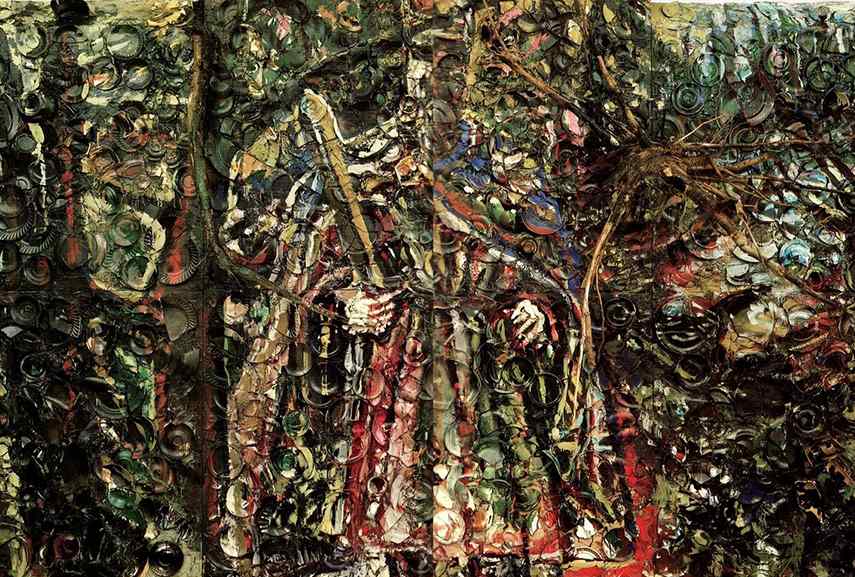
Neo-Expressionism as Assuming Art
Neo Expressionism held the same sentiment as its predecessor, and it was developed inside the frontiers of the aforementioned country. Deutschland was the one to requite rise to both expressionism and neo-expressionism, however the latter had almost simultaneously emerged in the United States and beyond other countries too, such as Italy, whose Transavanguardia became one of the nigh prominent neo-expressionist groups. Consequently, the visual fashion is determined by an ideology rather than a recognizable aesthetic guideline.The neo-expressionists didn't try to evade figuration, but they weren't determined to perfect it either. The painting was oftentimes characterized by heavy paint and recognizable brushwork, although not exclusively. The works that fall nether this category are hence diverse in mode, but known for a like arroyo to art - bold, intense, adventurous and therefore quite controversial. Once you take a look at the list of artists who autumn under this category, y'all will realize the "controversial" part yourself. In a manner, the neo-expressionist approach to fine art was close to that of outsider art, since both styles shared a lack of concern for contemporary aesthetics.

Neo-Expressionism and the Art Marketplace - Rise and Fall
Even so, it is non the content of these artworks that made Neo-Expressionism slightly "taboo-ish". The thing that is almost instantly linked to this movement is its connectedness to the art market, and the sudden boom it made in the 1980's, followed by a devastating collapse (which is also what makes it clearly different from outsider art). For some reason, the artworks that became related to the motion were praised and endorsed at first, and then forcefully rejected in the end. The reasons for this art market affair could be explained in several ways. The movement certainly came equally a refreshment which suggested another perspective when looking at art, even if only for a niggling while. On the other manus, information technology reached its peak in a particularly strange moment, when the art market expanded, which was followed past an increasing interest of investment firms. These were the circumstances that fabricated neo-expressionism too easy of a target in terms of dealing and evaluating fine art. Consequently, a few of the most prominent neo-expressionists became celebrities whose art dominated the art market place in a big way, among them Jean Michel Basquiat, whose life tragically ended maybe fifty-fifty due to this overnight success, since the excessive amount of sudden fame isn't something all of us tin can handle with ease.
Exist sure to cheque out works by Basquiat on our marketplace!
The Critical Response in the late 80s
By the late 80'southward, information technology seemed like the art market was starting to lose interest in neo-expressionism, turning to "critical" postmodernism and seeking for a more than openly advanced arroyo. What was once seen as a quality, which is the non-idealizing, fauvist outlook on art, was later considered regressive and "traditional", with a negative connotation. Given that the way is mostly associated with painting, every bit the well-nigh primitive course of artistic expression, information technology also became an example used to illustrate the conservative nature of the genre. Since the conspiracy coincided with the emergence of new art media, the semi-traditional neo-expressionism was destined to face fatal consequences. In addition, the antifeminist undertone that the grouping was sometimes attributed with was of no aid either.
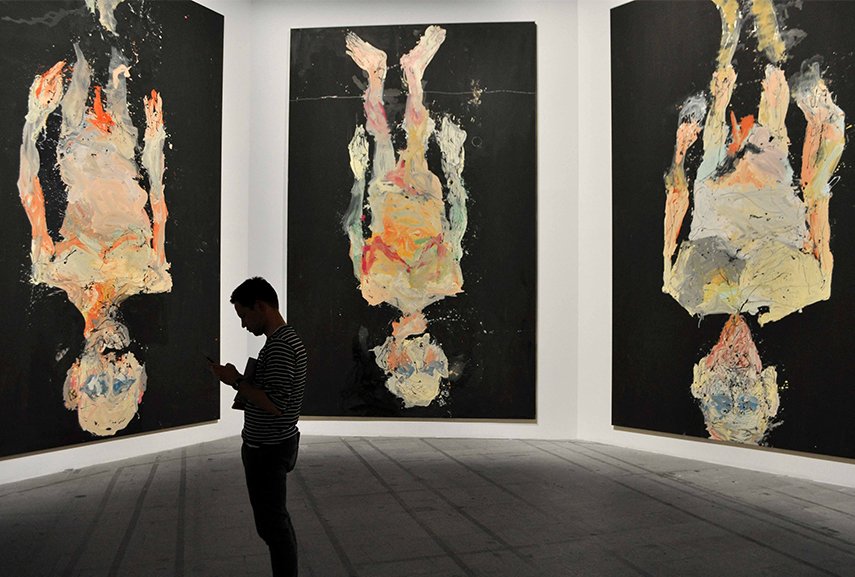
Importance and Legacy of Neo-Expressionism Artists
Since Neo-Expressionism wasn't a regular art movement, it didn't have its own focus, or a statement, or a manifesto. Artists who carried out the thought, both European and American, shared certain similarities in their artistic arroyo, although their individual expressions differed greatly. However, the significance of the Neo-Expressionism equally a move lies in characteristics all those artists had in common. These shared features included an extreme expressiveness of color, figurative subject matter, and a significant surface texture. Their piece of work had normally been immediate, committed to the topics that the whole society shared and went through without certainty. It was that indecision that actually explained their vitality and their limitations the all-time style. The closest relations with the Neo-Expressionism grouping have had New York-based artists at the time, such as Eric Fischl, Jean-Michel Basquiat, and Robert Longo, but their fellow artists in Europe, particularly in Germany and Italian republic, followed through. The whole move encompassed trends in Italian Transavanguardia and the uprise of High german postal service-war painters, such equally Georg Baselitz, and Anselm Kiefer. Now, allow's accept a look at what those leading Neo-Expressionists and their piece of work meant for the world of fine art.

Georg Baselitz - Reviving the German Expressionism

Georg Baselitz is a German painter and sculptor who founded the Neo-Expressionist group chosen Neue Wilden (New Wild, or the New Fauves as some call it). Neo-Expressionism in Germany bankrupt away from the intellectual distance, brainchild, and formalism of the Conceptual fine art every bit the predominant movement of the 1970s. Baselitz focused on provocative subject matter and the importance of colour in his paintings. He was born on the east side of the Berlin wall merely soon moved to West Berlin. In that location, he embraced abstruse art, just to walk away from it soon after. Instead of turning to Conceptual art or Pop Art, as many artists did at the time, Georg revived the German Expressionism, previously shut down by the Nazis, and he returned the human figure to a central position in the painting and sculpture. Eventually, he became well-known for expressing his beliefs and concerns through artworks, without any taboos or stereotypes, and often with sexual connotation, or of excessively dark nature.
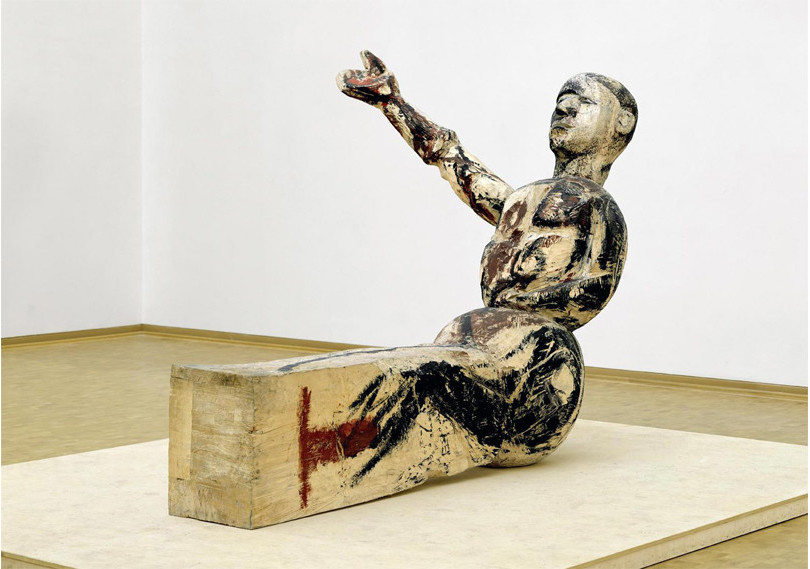
Jean-Michel Basquiat - Merging Punk with Graffiti Art

Jean-Michel Basquiat was a New-York based artist who became famous during the 1980s for his emotionally-charged paintings, and quite unique graffiti art which is nonetheless considered to be among the nearly avant-garde artworks of the second half of the 20th century in America. Basquiat was the beginning African-American artist who gained international fame, and the one who easily transferred from his downtown origins to fine art galleries. His work boosted the Neo-Expressionist movement in the U.S. and Basquiat eventually became one of the nigh acclaimed American Neo-Expressionists. His artistic practice successfully merged his Punk counterculture attitude with tradition and African-Caribbean heritage, altogether creating quite specific visual collages, which he mainly presented through street art and graffiti.
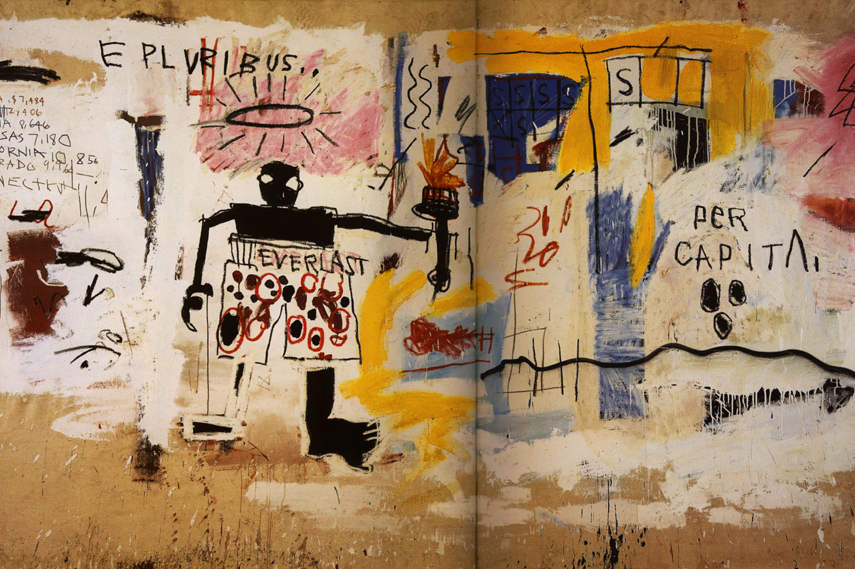
Philip Guston - Painting is an Illusion

American artist Philip Guston experimented with social realism and mural painting, and then with a cartoon realism in his early career, during the 1930s. But, he became renown later on, as an Abstract Expressionist. His paintings represented dreamlike scenes with shadowy abstractions hovering like mist in the foreground. "Painting is an illusion, a piece of magic, so what y'all meet is non what you see", Guston used to say. The creative person was initially associated with the New York School of abstruse art, but he totally abandoned pure abstraction in the 1950s and turned to figurative art and quasi-abstract drawing imagery. His later work, for which he became famous worldwide, had an enormous influence on the development of Neo-Expressionism in the U.S.

Anselm Kiefer - Facing the Holocaust

Anselm Kiefer is a German painter, sculptor, and a mixed-media artist. Topics he covers in his art ordinarily correspond with questions of national identity and German language history, especially issues regarding the Holocaust. He interrogated these themes in the era when those subjects were nonetheless taboo, only his artworks forced his contemporaries to bargain with the German language by. Although, every bit the New York Times wrote back in 1986, in that location were nevertheless questions about whether Kiefer had been also close to troublesome aspects of the High german war history. Besides that, the question was asked in the essay named Anselm Kiefer and the Exodus of the Jews, published in the Oct-December issue of the Australian art journal Art & Text. In that essay, fine art critic Peter Schjeldahl made one of the get-go attempts to systematically deal with the content of Kiefer'due south paintings. Kiefer was highly influenced past his German language colleague Georg Baselitz, delving in topics such as the history of the Holocaust, only also the occult, cosmos, and mythology.
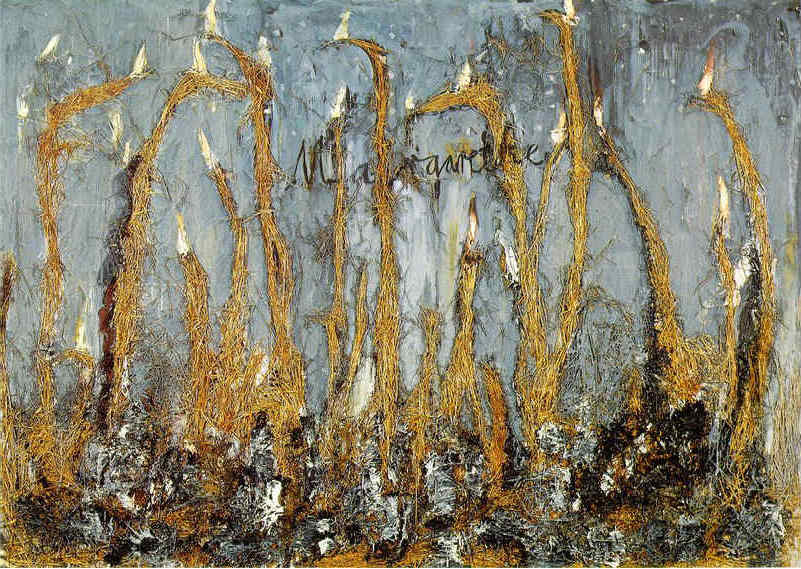
Eric Fischl - Bad Boy of Neo-Expressionism

Another influential figure of the movement in the U.s. was Eric Fischl, an American painter, sculptor, and a printmaker. His artistic opus includes colorful portraits, suburban interiors, and beach scenes, and topics that occupied Fischl's attention the most were the problems regarding a human body and sexuality. Other than that, Eric Fischl is interested in exploring the modern American lodge. Back in the 1980s, he became known as the bad boy of Neo-Expressionism, because of his depictions of American marginalized suburbs, referring to everyday life and human vulnerability without any brand-up and masks put upon.
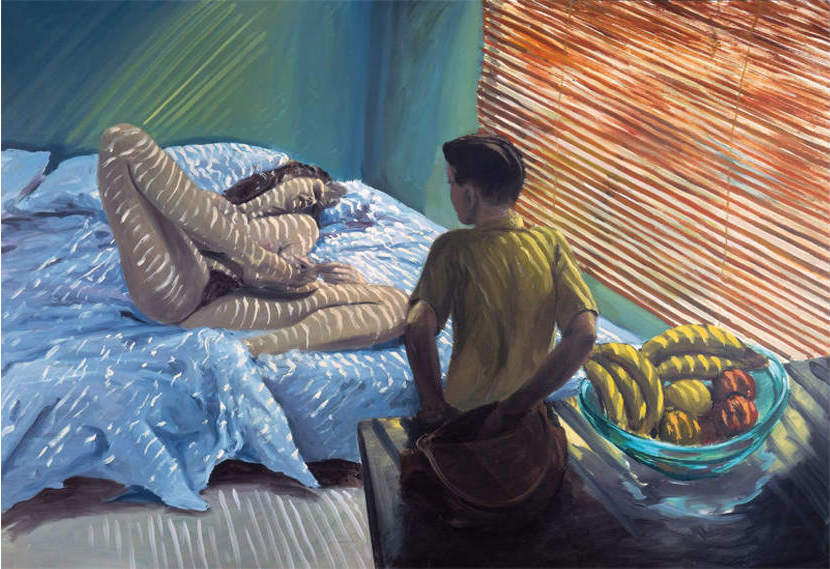
Francesco Clemente - Exploring Sexuality and Raw Emotions

Neo-Expressionism movement in Italy was also known equally the Italian Transavanguardia, and 1 of its leading artists used to be Francesco Clemente. Similar to other Neo-Expressionists, his work also contained much of a relation to sexuality, raw emotions, and even brutality. He depicts a dark side of humanity, usually unspoken and held back. In his paintings, Clemente incorporates some visual elements of Surrealism, as well equally the signs and symbols of other cultures, such as Hindu spiritualism in Republic of india, or the Candomble religion of Brazil. Art critics throughout the 1980s claimed him to exist the near articulate among other Neo-Expressionists at the time. He was the i with the simplest technique, too, and with the almost international references. Today, Clemente continues to explore individual identity, constantly questioning the idea of oneself.
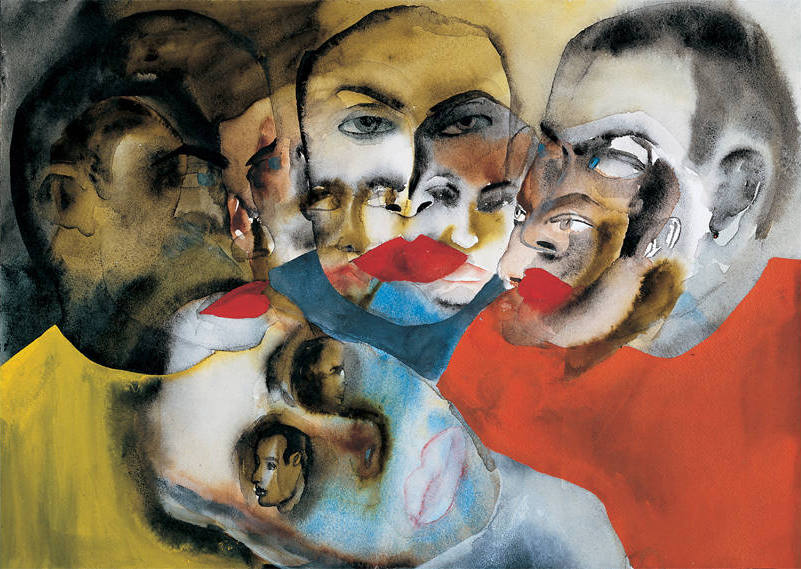
David Salle - Dealing with Voyeurism

The sexual connotation was besides very strong within the artwork of American painter David Salle. His paintings, installations, and photographs often deal with voyeurism, sex, and the scrutiny. Other than that, Salle's body of piece of work is inspired past the advertizing industry, consumerism, and contemporary events effectually the creative person and around the world. Through his paintings, he manages to brand something familiar get odd past using unexpected details or foreign compositions. Such work of him is the diptych Comedy from 1995. The left part of it is executed in a historical technique grisaille used for rendering figures, while the right office depicts a habitation scene derived from a 1950s advertisement, but turned on its side and layered with additional imagery. During the 1990s, Salle involved himself more with the costume design, movie theater, and performing arts.
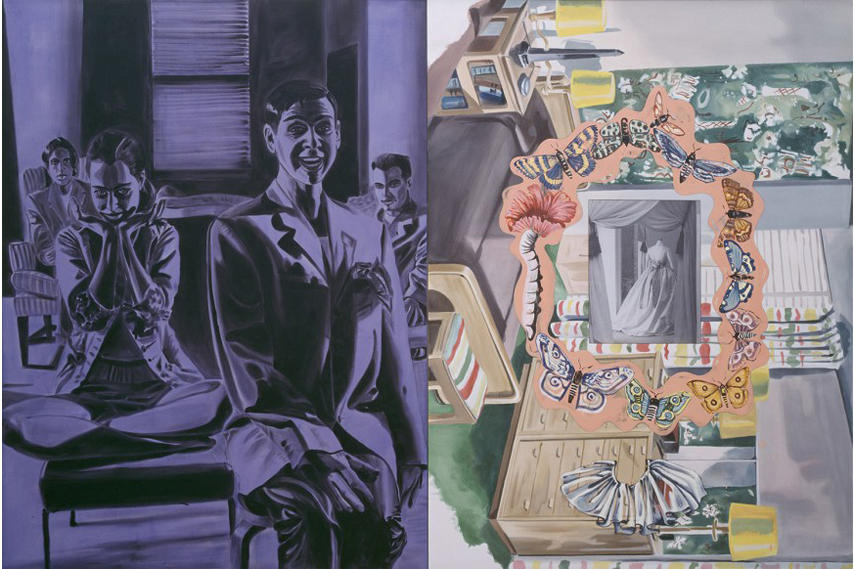
Robert Longo - Fascinated with Moving Images

American painter and sculptor, Robert Longo became famous in the 1980s, when he entered the New York art scene with his large-calibration series Men in the Cities, which depicted sharply dressed men and women in twitched poses. For this detail series, which he had been creating from 1979 to 1982, Longo photographed his friends leaning forward, lurching astern, or collapsing over the invisible pavement. Afterward, he enlarged the pictures through a projector, and drew them in various sizes, ranging from iii-quarter calibration to big-scale images. During the procedure, Longo attentively dramatized poses and standardized the outfit to black-and-white formal clothing. At the time he burst the scene, Neo-Expressionism was at its height, and so Longo smoothly embedded with the movement'due south aesthetics. However, his high school fascination with mass media, film and other moving images have led Longo's career towards making photographs and 3D objects often based on film and television receiver images. As well, the usual topics of Robert Longo's photo-pieces are the tyranny and potential of mass-media in the world today.
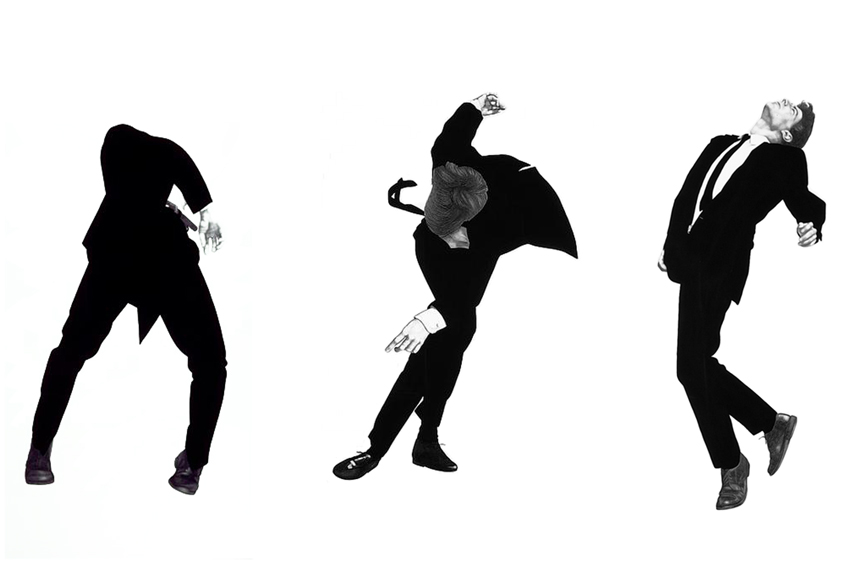
Where Are We At present?
The 90'due south were followed by a significant technological advocacy, which climaxed in the 2000s and the early 2010s. The Internet era was a major turning signal in every fashion, and therefore in art as well, which meant that there was less interest in neo-expressionism in general. Notwithstanding, since we are already witnessing the emergence of Post Net Art, it seems similar there is a hazard for the traditional genres to rising once again. Painting was proclaimed dead two centuries ago, but information technology seems like the painting market is doing simply fine in 2016 later on all. As a matter of fact, the global auction volume for Basquiat'due south piece of work was over $115m in 2007, which is more he could've earned back in the 1980's, as the currents seem to exist shifting in favor of the 1980's neo-expressionists again.

Is Neo-Expressionism Simply a Affiliate in Art History?
Permit us try to go dorsum to this article's point of departure. Is expressionism, or neo-expressionism, really a matter of trend or a affair of sensibility? Since the very concept of the movement is, literally, expressing i's subjective feelings and thoughts with no regard to the external world, there must be some artists who approach fine art with this trend today - and there must have been a scattering of them who did that in the by, for that matter. Some refer to David Hockney's early works and Francis Bacon's paintings as purely expressionist, yet the movement was officially inaugurated a bit later. With that in heed, it'south non actually clear if detecting expressionism today is only a way of acknowledging expressive painting, or truly finding a trace of influence from the past. In case nosotros do try to class a list of today'southward neo-expressionists, it would definitely include those who were actually part of the movement dorsum in the 80's and continue to piece of work today, such equally Anselm Kiefer or Georg Baselitz, and perhaps those who were never officially admitted to the group, just resonated with the style in many ways, such equally the South African artist Marlene Dumas. If we attempt to accept a pace farther, nosotros could end up listing some of the artists of a younger generation. Had Ali Banisadr's indefensibly expressive art emerged a few decades earlier, for example, it might have been placed right adjacent to that of Kiefer and Salle. Perchance the aforementioned thing could be said for Tracey Emin, whose drawings e'er await like a reflection on the same inner self. But is this really a legitimate way to discern the remains of neo-expressionism? Or is information technology a term reserved for the decade-or-so long period ruled by the art market? We might have to expect a few more decades to find out.
Written by Natalie P and Nadia Herzog.
Featured images: Jean Michel Basquiat - Dustheads, 1982; Anselm Kiefer - Zim Zum, 1990; Francesco Clemente - Alba. All images used for illustrative purposes only.
Source: https://www.widewalls.ch/magazine/neo-expressionism-art-movement